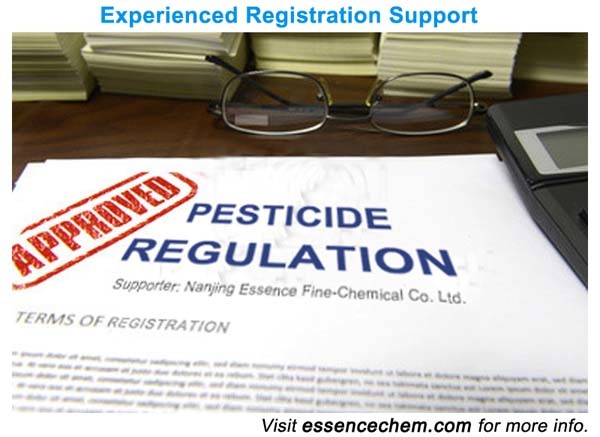Chlorothalonil 20% + Dimethomorph 20% Fs Fungicide
Chlorothalonil NOMENCLATURE
Common name chlorothalonil (BSI, E-ISO, (m) F-ISO, ANSI); TPN (JMAF)Â
IUPACÂ name tetrachloroisophthalonitrile
Chemical Abstracts name 2,4,5,6-tetrachloro-1,3-benzenedicarbonitrileÂ
CASÂ RNÂ [1897-45-6]
Chlorothalonil APPLICATIONS
Chlorothalonil Biochemistry Conjugation with, and depletion of, thiols (particularly glutathione) from germinating fungal cells, leading to disruption of glycolysis and energy production, fungistasis and fungicidal action.
Chlorothalonil Mode of action Non-systemic foliar fungicide with protective action.
Chlorothalonil Uses Control of many fungal diseases in a wide range of crops, including pome fruit, stone fruit, almonds, citrus fruit, bush and cane fruit, cranberries, strawberries, pawpaws, bananas, mangoes, coconut palms, oil palms, rubber, pepper, vines, hops, vegetables, cucurbits, tobacco, coffee, tea, rice, soya beans, peanuts, potatoes, sugar beet, cotton, maize, ornamentals, mushrooms, and turf. Application rates for food crops are 1-2.5 kg/ha. Also used for protection from mildew of dry paint films and other coatings, protection of wood from mould, sapstain and decay. Phytotoxicity Russetting is possible with flowering ornamentals, apples, and grapes. Some varieties of flowering ornamentals may be injured. Pittosporum foliage is sensitive. Phytotoxicity may be increased with oils or oil-containing substances.
Chlorothalonil Compatibility Not compatible with oils.
Dimethomorph NOMENCLATURE
Common name dimethomorph (BSI, E-ISO); diméthomorphe ((m) F-ISO)Â
IUPACÂ name (E,Z)-4-[3-(4-chlorophenyl)-3-(3,4-dimethoxyphenyl)acryloyl]morpholine
Chemical Abstracts name (E,Z)-4-[3-(4-chlorophenyl)-3-(3,4-dimethoxyphenyl)-1-oxo-2-propenyl]morpholine CAS RN [110488-70-5]Â
Dimethomorph APPLICATIONS
Dimethomorph Biochemistry Proposed inhibitor of phospholipid biosynthesis and cell wall synthesis. Inhibits the formation of the oomycete fungal cell wall.
Dimethomorph Mode of action Local systemic fungicide with good protectant and antisporulant activity. Only the (Z)- isomer is intrinsically active, but, because of rapid interconversion of isomers in the light, it has no advantage over the (E)- isomer in practice.
Dimethomorph Uses Fungicide effective against Oomycetes, especially Peronosporaceae and Phytophthora spp. (but not Pythium spp.) in vines, potatoes, tomatoes and other crops. Used in combination with contact fungicides, and applied at 2.0-2.5 kg formulated product/ha.



 Chlorothalonil 20% + Dimethomorph 20% FS
Chlorothalonil 20% + Dimethomorph 20% FS
Chlorothalonil NOMENCLATURE
Common name chlorothalonil (BSI, E-ISO, (m) F-ISO, ANSI); TPN (JMAF)Â
IUPACÂ name tetrachloroisophthalonitrile
Chemical Abstracts name 2,4,5,6-tetrachloro-1,3-benzenedicarbonitrileÂ
CASÂ RNÂ [1897-45-6]
Chlorothalonil APPLICATIONS
Chlorothalonil Biochemistry Conjugation with, and depletion of, thiols (particularly glutathione) from germinating fungal cells, leading to disruption of glycolysis and energy production, fungistasis and fungicidal action.
Chlorothalonil Mode of action Non-systemic foliar fungicide with protective action.
Chlorothalonil Uses Control of many fungal diseases in a wide range of crops, including pome fruit, stone fruit, almonds, citrus fruit, bush and cane fruit, cranberries, strawberries, pawpaws, bananas, mangoes, coconut palms, oil palms, rubber, pepper, vines, hops, vegetables, cucurbits, tobacco, coffee, tea, rice, soya beans, peanuts, potatoes, sugar beet, cotton, maize, ornamentals, mushrooms, and turf. Application rates for food crops are 1-2.5 kg/ha. Also used for protection from mildew of dry paint films and other coatings, protection of wood from mould, sapstain and decay. Phytotoxicity Russetting is possible with flowering ornamentals, apples, and grapes. Some varieties of flowering ornamentals may be injured. Pittosporum foliage is sensitive. Phytotoxicity may be increased with oils or oil-containing substances.
Chlorothalonil Compatibility Not compatible with oils.
Dimethomorph NOMENCLATURE
Common name dimethomorph (BSI, E-ISO); diméthomorphe ((m) F-ISO)Â
IUPACÂ name (E,Z)-4-[3-(4-chlorophenyl)-3-(3,4-dimethoxyphenyl)acryloyl]morpholine
Chemical Abstracts name (E,Z)-4-[3-(4-chlorophenyl)-3-(3,4-dimethoxyphenyl)-1-oxo-2-propenyl]morpholine CAS RN [110488-70-5]Â
Dimethomorph APPLICATIONS
Dimethomorph Biochemistry Proposed inhibitor of phospholipid biosynthesis and cell wall synthesis. Inhibits the formation of the oomycete fungal cell wall.
Dimethomorph Mode of action Local systemic fungicide with good protectant and antisporulant activity. Only the (Z)- isomer is intrinsically active, but, because of rapid interconversion of isomers in the light, it has no advantage over the (E)- isomer in practice.
Dimethomorph Uses Fungicide effective against Oomycetes, especially Peronosporaceae and Phytophthora spp. (but not Pythium spp.) in vines, potatoes, tomatoes and other crops. Used in combination with contact fungicides, and applied at 2.0-2.5 kg formulated product/ha.



